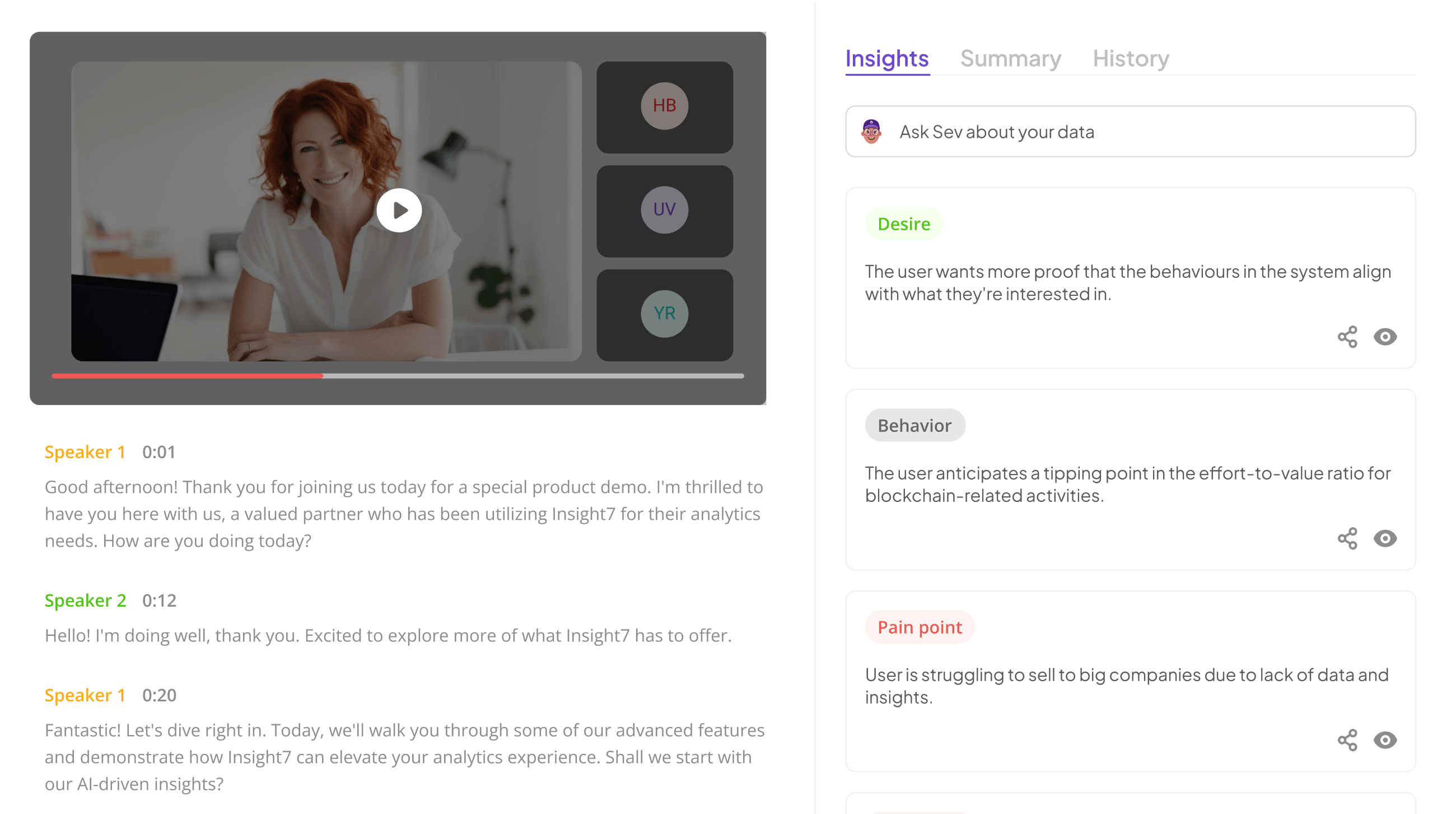5 Quick Coaching Tips Before a High-Stakes Sales Call
-
Bella Williams
- 10 min read
Sales Call Preparation is the foundation of a successful interaction between a salesperson and a potential client. Imagine walking into a high-stakes call, armed with insights and a clear strategy, ready to engage with confidence. This preparation not only sets the stage for a productive conversation but also increases the likelihood of closing the deal.
Effective sales call preparation involves understanding client needs, setting clear objectives, and honing communication skills. By dedicating time to these elements, sales professionals can create a welcoming atmosphere and establish trust. Engaging with clients thoughtfully and responding to their inquiries ensures that the conversation remains focused and meaningful, ultimately leading to a more favorable outcome.
Analyze & Evaluate Calls. At Scale.

Mastering Your Sales Call Preparation
Mastering your sales call preparation involves a strategic approach to maximize your effectiveness. First, you should gather all relevant client information, including any past interactions. Understanding these details allows you to tailor your pitch to the client's unique needs, demonstrating your attentiveness and expertise.
Next, set specific objectives for your call. This could range from establishing rapport or identifying client pain points to closing a deal. Having clear goals guides the conversation and ensures you stay focused throughout. Additionally, practicing active listening during the call will help you gauge the client’s responses and adjust your approach accordingly. By mastering your sales call preparation, you position yourself not just as a salesperson, but as a trusted advisor ready to provide solutions that matter to your clients.
Understanding the Clients Needs
Understanding the client's needs is pivotal in ensuring a successful sales call. Start by actively listening to your clients, which allows you to uncover their unique challenges and aspirations. Identifying their pain points not only demonstrates genuine interest but also enables you to tailor your solutions effectively. Reflect on past interactions and utilize feedback to refine your understanding of what clients truly value.
Next, ask open-ended questions during your conversations. This encourages clients to share more detailed insights, giving you a comprehensive view of their expectations. Before the call, review any previous notes or data to gain deeper insight into their history and preferences. By doing so, you position yourself as a knowledgeable consultant rather than just a salesperson, enhancing your credibility and connection with the client. Ultimately, prioritizing clients' needs will lead to stronger relationships and increased opportunities in high-stakes sales situations.
Setting Clear Objectives
Before a high-stakes sales call, setting clear objectives is essential for success. Begin by defining what you hope to achieve during the conversation. This could be securing a follow-up meeting, presenting a product demo, or closing a deal. Having these goals in mind not only guides your conversation but also helps you stay focused amidst any distractions.
To effectively set your objectives, consider three key points. First, prioritize your goals based on their impact on overall sales strategy. For example, if closing the sale is feasible, focus on that. Second, align your objectives with the client’s needs, ensuring a mutual benefit. Lastly, keep objectives specific and measurable, allowing for a clear assessment of your success post-call. This clarity in aim empowers your sales call preparation and enhances the likelihood of achieving desired outcomes.
Tools to Enhance Sales Call Preparation
Preparing for high-stakes sales calls can significantly affect your success rate. Utilizing the right tools fosters effective Sales Call Preparation, enabling you to engage your prospects more meaningfully. One effective tool is Insight7, which provides critical insights to help tailor your conversations. By analyzing previous interactions, you can understand customer needs better, enhancing your overall approach.
Additionally, tools like LinkedIn Sales Navigator help connect you with the appropriate prospects, enabling a targeted outreach strategy. Meanwhile, HubSpot CRM streamlines customer data management and facilitates a cohesive view of all interactions. Lastly, Gong allows you to record and analyze calls, providing continuous feedback that improves your skills over time. Employing these tools not only enhances your readiness but also transforms your sales calls from mere transactions into consultative conversations.
Insight7: Delivering critical insights for effective preparation
Effective sales call preparation hinges on gathering critical insights that refine your approach. Understanding the client's needs and market conditions allows you to create a tailored conversation. To harness these insights, immerse yourself in research about the client’s industry and competitors. This knowledge equips you to address their unique challenges and offer relevant solutions.
In addition, consider implementing customer feedback and data analysis tools to gain a deeper perspective. These tools can help you uncover trends and sentiments that may not be immediately obvious. Establishing clear objectives based on these insights will enable you to steer the conversation effectively. Remember, preparation is not just about knowing what to say, but also about being adaptable to the client's responses during the call. By being well-equipped, you stand a better chance of building rapport and closing deals.
Extract insights from interviews, calls, surveys and reviews for insights in minutes
LinkedIn Sales Navigator: Connecting you with the right prospects
LinkedIn Sales Navigator is an invaluable tool for connecting with the right prospects, especially when preparing for high-stakes sales calls. This platform empowers users to generate leads by providing actionable insights into potential clients. By utilizing refined search filters, you can pinpoint decision-makers and key influencers within your target industries. This targeted approach enhances your understanding of client needs, allowing for a more personalized and effective sales conversation.
To maximize the benefits of LinkedIn Sales Navigator, focus on three specific strategies. First, utilize advanced search capabilities to create a list of ideal prospects, paying attention to their professional backgrounds and interactions. Second, leverage saved leads and account features to stay updated on any changes in your prospects’ circumstances, enabling timely follow-ups. Finally, integrate insights gathered from Sales Navigator into your call preparations, ensuring your approach is relevant and contextual. This preparation not only boosts your confidence but also increases the likelihood of a successful sales outcome.
HubSpot CRM: Streamlining your customer data management
Preparing for a high-stakes sales call can be daunting, especially when navigating vast amounts of customer data. With the right tools, you can streamline your customer data management for a more effective approach. Utilizing an intuitive CRM platform offers a centralized hub for all customer interactions, providing insights that can shape your call strategy. This ensures that you're informed about your prospect's history, preferences, and pain points, which is critical for establishing a connection.
During your sales call preparation, accessing organized data can significantly reduce time spent on research. You can analyze past conversations and identify trends that reveal customer needs. With features like call transcriptions and insights extraction, you are equipped to enter the discussion confidently. Leveraging this streamlined approach not only enhances your focus but also empowers you to engage your prospects with precision and clarity, ultimately fostering a more productive sales environment.
Gong: Recording and analyzing sales calls for continuous improvement
Recording and analyzing sales calls is essential for continuous improvement, providing valuable insights into sales performance. By utilizing a recording platform, sales teams can revisit calls to identify strengths and weaknesses. This process begins with selecting a sufficient number of calls to evaluate, ensuring a broad perspective on typical sales conversations. Quantifying aspects such as tone, pacing, and content adherence enables teams to benchmark their performance effectively.
Once calls are recorded, the analysis can focus on specific criteria relevant to sales success. For instance, teams can examine how well sales representatives clarify customer needs or present product benefits. Documenting these insights fosters a culture of continuous improvement. This feedback loop not only supports targeted training efforts but also helps in devising strategies to enhance overall effectiveness during future sales interactions. By refining their approach, sales professionals can significantly boost their chances of success in high-stakes calls.
Conclusion: Perfecting Your Sales Call Strategy
To perfect your sales call strategy, it's essential to incorporate effective sales call preparation techniques that align with your unique approach. Start by synthesizing the insights from your research to understand your clients' needs deeply. This knowledge enables you to tailor your conversation, enhancing customer engagement and trust.
Next, reflect on the objectives you've set for the call. Are they clear and achievable? By staying focused on these goals, you can steer the discussion toward valuable outcomes. Remember that each high-stakes call is an opportunity to refine your strategy, adapting to feedback and experiences for future success.
Analyze & Evaluate Calls. At Scale.








